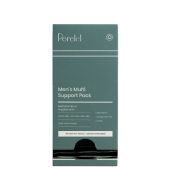Like so many aspects of PMS (and our menstrual cycles in general), we're taught that navigating big mood swings is just "part of being a woman"—like white knuckling it through painful cramps and severe bloating, or dealing with excessive hormonal acne. Spoiler alert: Many of these symptoms can actually indicate an underlying imbalance or condition, and feeling particularly low in the days leading up to your period is no exception. In fact, it can be a sign of Premenstrual Dysphoric Disorder, or PMDD.
The good news? Once you nail down a PMDD diagnosis, this condition is treatable. Below, let's get into the signs of PMDD—and how you can work with your healthcare provider to address your symptoms.
Is It Just PMS?
Before we get into the specific symptoms that correlate with PMDD, let's do a quick refresher on Premenstrual Syndrome, or PMS. PMS includes the physical and emotional symptoms caused by hormonal imbalances before your period starts. PMS happens during the luteal phase, which begins about 14 days before the start of your period. Symptoms usually start between five and seven days before your period.
Hormonal imbalances happen when the levels of the hormones estrogen and progesterone change during your menstrual cycle. PMS affects 75 percent of women with regular periods, and there are more than 150 (!) symptoms that can happen in the days leading up to menstruation.
The most common symptoms are:
-
Psychological changes and emotional symptoms like anxiety, sadness, extreme moodiness, depression, and irritability.
-
Physical symptoms, such as breast tenderness, headaches, and bloating.
-
Behavioral symptoms, like poor concentration, forgetfulness, less interest in usual activities, and tiredness.
That said, if these symptoms are severe enough to disrupt your daily life, there could be something else at play.
Shop the Article:
What is premenstrual dysphoric disorder?
PMDD causes severe mood and physical symptoms one to two weeks before the start of your period. These symptoms normally go away a few days after your period starts.
It’s a serious medical condition that became an official diagnosis in the Diagnostic and Statistical Manual of Mental Disorders, or DSM-5 (the manual clinicians use to classify mental health problems) as of 2013. It's currently estimated that between three and eight percent of reproductive-age women meet the criteria for PMDD.
PMDD symptoms are similar to premenstrual syndrome (PMS) symptoms but more intense.
Some PMDD symptoms are:
-
Unmanageable depression
-
Thoughts about hurting yourself or suicide
-
Not caring about things you’re passionate about or your daily routines
-
Panic attacks
-
Problems with your relationships and friendships
-
Being unable to sleep and feeling tired or low energy all the time
-
Difficulty concentrating
-
Changes in appetite, like overeating
What causes PMDD?
Researchers think PMDD is caused by a negative reaction in the brain to hormonal changes that happen during our menstrual cycles. Some people are more sensitive to these shifts in hormone levels, possibly because of their genetics.
How is PMDD diagnosed?
PMDD is diagnosed using specific things listed in the DSM-5, like when and how bad your symptoms are. Your doctor might ask to see you multiple times over a period of time to ensure that a PMDD diagnosis is accurate.
Some things your doctor might do when they’re diagnosing PMDD are:
-
Take your medical history.
-
Ask you to keep a diary of your symptoms for two periods.
-
Tests or exams to rule out other possible causes.
-
Work with mental health specialists to confirm you have PMDD and figure out a personalized treatment plan.
How is PMDD treated?
A few ways to treat PMDD include:
-
Medications like selective serotonin reuptake inhibitors (SSRIs), a type of antidepressant, are the first line of treatment.
-
Nutritional supplements like calcium, magnesium, vitamin B6, and omega-3 fatty acids.
-
Herbal remedies like chasteberry/vitex and evening primrose oil.
-
Acupuncture, the practice of inserting thin needles into specific points on the body, may help relieve pain and regulate your mood.
-
Techniques such as yoga, meditation, deep breathing exercises, and mindfulness-based stress reduction (MBSR) may help reduce stress and improve overall well-being.
-
Regular physical activity, such as aerobic exercises, yoga, or higher-impact training like weightlifting, can help boost your mood and reduce stress.
Are there any resources that can help me?
If you think you might have PMDD, you can use the International Association for Premenstrual Disorders’ self-screening tool PMDD/PME Self Screen before seeing your doctor.
If you have PMDD or your doctor has asked you to track your symptoms, the PMDD Symptom Tracker is a useful app that makes tracking easier.
How can I talk about this?
Some things you might say to your doctor are:
- “I’m having a really hard time before my period. Do you think my symptoms could be PMDD?”
- “How is PMDD diagnosed?”
- “What treatment options do you recommend for managing PMDD?”
Takeaways
PMDD can cause severe depression, suicidal thoughts, panic attacks, and relationship problems—but it is treatable. If you've navigated these kinds of mental health challenges ahead of your period (or ever, for that matter), it's best to check in with your healthcare provider right away.
Sign up to receive doctor-backed, stage-specific content in your inbox each week.
theFolio in Your Inbox
This article is for informational purposes only. It is not, nor is it intended to be, a substitute for professional medical advice, diagnosis, or treatment and we recommend that you always consult with your healthcare provider. To the extent that this article features the advice of physicians or medical practitioners, the views expressed are the views of the cited expert and do not necessarily represent the views of Perelel.
Resources:
- Ryu, Aeli, and Tae-Hee Kim. "Premenstrual syndrome: A mini-review." Maturitas 82, no. 4 (2015): 436-440.
- Halbreich U, Borenstein J, Pearlstein T, Kahn LS. The prevalence, impairment, impact, and burden of premenstrual dysphoric disorder (PMS/PMDD). Psychoneuroendocrinology. 2003
- What is PMDD? International Association for Premenstrual Disorders. 2019
- Beddig, Theresa, Iris Reinhard, and Christine Kuehner. “Stress, mood, and cortisol during daily life in women with Premenstrual Dysphoric Disorder (PMDD).” Psychoneuroendocrinology 109 (2019): 104372.





















